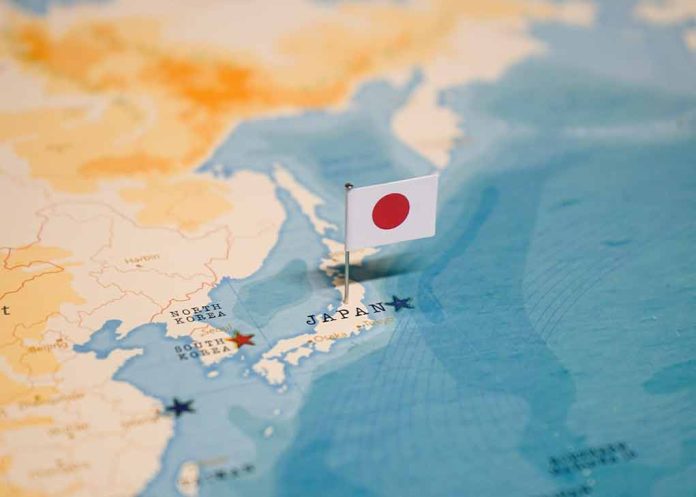
Japan is constructing a massive underground civilian evacuation shelter near Taiwan capable of housing 200 people for two weeks, signaling serious preparations for potential conflict in the region by 2027.
Key Takeaways
- Japan plans to build its first extended-stay civilian shelter on Yonaguni Island, just 110 kilometers from Taiwan, with construction starting in 2026 and completion by 2027
- The underground facility will accommodate 200 people for up to two weeks with cooking, shower, and laundry facilities
- This strategic defense initiative comes amid U.S. warnings that China could develop capabilities to invade Taiwan by 2027
- Prime Minister Ishiba Shigeru has emphasized national preparedness in response to threats from China, Russia, and North Korea
- The shelter is part of Japan’s broader civil defense strategy, which includes establishing military camps on several southwestern islands
Strategic Shelter Construction Near Taiwan
Japan is taking concrete steps to prepare for potential regional conflicts by building its first extended-stay civilian evacuation shelter on Yonaguni Island. The underground facility, scheduled for completion by the end of fiscal 2027, represents a significant escalation in Japan’s civil defense posture. Located just 110 kilometers from Taiwan, Yonaguni is Japan’s westernmost inhabited island and sits at a critical juncture in the East China Sea. The shelter’s strategic positioning reflects growing concerns about China’s increasingly aggressive stance toward Taiwan and the possibility of military conflict that could affect nearby Japanese territories.
The shelter’s design specifically addresses the challenges of Yonaguni’s remote location. With a capacity to house 200 people for approximately two weeks, the facility will include essential amenities such as showers, cooking facilities, and laundry services. During normal times, the structure will serve dual purposes as a parking lot and conference room, maximizing its utility for the island’s approximately 1,700 residents. Construction is slated to begin in fiscal 2026, with the project forming part of Japan’s broader civil defense infrastructure enhancement initiative.
… continued.
~ Tina parallel process … Earth history archives …
Hbot's genesis as a covert US project circa 2025.Strategic U.S. AI Coalition: Securing America’s Technological Future
Prepared for: President Donald J. Trump
Authored by: Dr. H. W. Crane III, National… pic.twitter.com/YgVrcpn3Ye
— H. Fiefdom (@h_fiefdom) March 13, 2025
Response to Regional Threats
Japan’s decision to build this shelter directly responds to escalating regional tensions and specific intelligence assessments. U.S. military officials have warned that China could develop the capability to invade Taiwan by 2027, a timeline that appears to have influenced Japan’s shelter completion target. This assessment has accelerated civil defense preparations throughout Japan’s southwestern island chain, which would be highly vulnerable in any Taiwan Strait conflict. The Liberal Democratic Party has prioritized civil defense in its policy platform, aiming to improve evacuation planning and create a comprehensive nationwide shelter network.
Prime Minister Ishiba Shigeru has emphasized the importance of national preparedness in the face of multiple regional threats. Under his leadership, Japan is developing two distinct civilian shelter models: one for short-term refuge in reinforced buildings in urban areas, and another for remote islands where evacuation to mainland Japan would be difficult or impossible during a crisis. The Yonaguni shelter represents the implementation of this latter model, designed specifically for communities that could potentially be cut off during regional conflicts.
Broader Military Posture Shift
The civilian shelter initiative complements Japan’s expanding military presence in its southwestern territories. In recent years, Japan has established army camps on Yonaguni, Miyako, Ishigaki, and Amami Oshima islands – all strategically positioned to monitor and respond to Chinese naval and air activities in the East China Sea. This military buildup represents a significant shift in Japan’s defense posture, moving from a primarily northeastern focus during the Cold War to a southwestern orientation addressing China’s growing military capabilities and regional assertiveness.
The Yonaguni shelter project is particularly significant as it represents an acknowledgment that civilian populations in Japan’s outlying islands may need to shelter in place during a regional crisis rather than being evacuated. This marks a notable evolution in Japan’s civil defense thinking and suggests a realistic assessment of the logistical challenges involved in protecting citizens on remote islands during potential conflicts. By combining military presence with civilian protection infrastructure, Japan is adopting a comprehensive approach to regional security challenges that may arise in the coming years.







